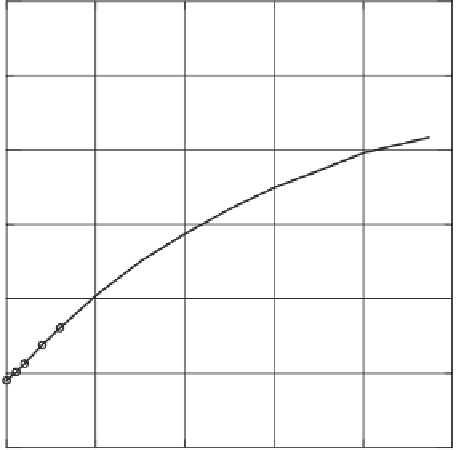Environmental Engineering Reference
In-Depth Information
λ
s
,λ
w
,λ
a
=
thermal conductivities of the solid, water,
and air phases, respectively.
3
Typical thermal conductivities for sand particles and water
are 6.0 and 0.57 W/m/
◦
C, respectively (de Vries, 1963;
Jame, 1977; Wilson, 1990). The thermal conductivity of air,
λ
a
, consists of two components (Jame, 1977; Wilson, 1990):
2
λ
a
=
λ
dry air
+
λ
water vapor
(16.76)
where:
0.025 W/m/
◦
C, and
λ
dry air
=
1
λ
water vapor
=
varies linearly between 0 and 0.0736 W/m/
◦
C for volumetric water content
θ
w
between
0 and 12.1%.
The weighting factors
f
can be calculated using the
assumption that the soil particles are ellipsoidal in shape.
The weighting factor for the continuous medium (i.e., air
or water) is equal to 1.0. Water can be selected as the
continuous medium with the
f
w
value equal to 1.0. The
weighting factors for the solid and air phases can then be
calculated in accordance with the following relationship:
0
0
5
10
15
20
25
Gravimetric water content,
w
(%)
Figure 16.21
Thermal conductivity versus water content for
Beaver Creek sand (from Wilson, 1990).
1
λ
λ
w
−
1
g
i
−
1
3
16.8 TWO-DIMENSIONAL STRESS-
DEFORMATION AND SATURATED-UNSATURATED
SEEPAGE ANALYSIS
1
3
f
=
+
(16.77)
i
=
1
where:
The most common volume change problem is related to
swelling and shrinking associated with expansive soils.
There are two physical processes involved when dealing with
expansive soils: (i) water movement and (ii) deformation
analysis. There is the movement of water either into the
ground or out of the ground. The movement of water into
the ground might be due to precipitation (i.e., rainfall or
snowmelt). The movement of water out of the ground is
through evaporation and evapotranspiration.
There is also a stress-deformation analysis which allows
the calculation of displacements resulting from a change in
the stress state of the soil. There are two PDEs that need to
be solved for a two-dimensional stress-deformation analysis
(i.e., one for the
x-
direction and one for the
y-
direction). The
combined stress-deformation and water seepage PDEs can
be solved in either a coupled or uncoupled manner.
Chapter 14 showed how the stress-deformation PDEs for
one-, two-, and three-dimensional analyses could be per-
formed when the initial and final boundary conditions were
known. It was the total amount of heave or settlement that
was the desired outcome from that analysis. In this chapter,
the case of two-dimensional problems involving expansive
clay will once again be analyzed; however, this time the
movement of water infiltration with respect to time will be
analyzed in combination with volume changes (i.e., stress-
deformation analysis).
f
=
f
a
,
f
s
,
λ
=
λ
a
,
λ
s
, and
g
=
depolarization factors for the ellipsoid (i.e.,
g
1
,
g
2
,
and
g
3
, where
g
1
+
1); the values of
g
1
,
g
2
, and
g
3
are independent of particle size and depen-
dent only on the ratio of the length of the ellipsoid
axes.
g
2
+
g
3
=
Wilson (1990) used equal depolarization factors of
1
/
3
when computing the weighting factors for a sandy soil. In
this case, the sand particles were assumed to have spher-
ical shapes. The depolarization factors
g
1
and
g
2
for the
air phase were assumed to decrease linearly from 0.333 to
0.105 for volumetric water content
θ
ranging from 23.6 to
12.1%, respectively, and from 0.105 to 0.015 for
θ
values
ranging from 12.1 and 0%, respectively (Jame, 1977).
Figure 16.21 illustrates the thermal conductivity
λ
varia-
tion for Beaver Creek sand with respect to volumetric water
contents as computed using Eqs. 16.75, 16.76, and 16.77.
The thermal properties of the unsaturated soil are presented
as functions of the water content of the soil; however, these
properties can also be written as functions of the stress state
(e.g., soil suction). Writing the thermal properties as a func-
tion of the stress state is more consistent with the manner
in which hydraulic properties are handled in geotechnical
engineering.



















Search WWH ::

Custom Search